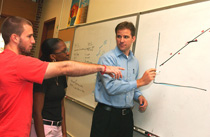Scholarship gives low-income kids a chance to work in UF science labs
On the University of Florida campus this summer, a researcher is studying the effects of prenatal cocaine exposure on fetal development. Another researcher is looking for ways to boost the levels of cancer-preventing compounds in broccoli. Yet another is examining the effects of pollution on tiny animals in Gainesville’s creeks.
All of these summer projects are being done by high school students – including low-income students from some of the state’s most stressed schools.

With a grant from the Smallwood Foundation, COE Assistant Professor Troy Sadler (right) is helping low-income high school students participate in UF's respected Student Science Training Program.
Through a grant from the Smallwood Foundation, UF’s College of Education is sending students from low-income families to the university’s Student Science Training Program – a seven week on-campus experience, administered by the UF Center for Precollegiate Education and Training (CPET), that for almost half a century has served as the pipeline to a brilliant career in the sciences.
“This program offers an authentic experience in the sciences that can not be replicated in classroom laboratories,” said Troy Sadler, an assistant professor in the College of Education and administrator of the grant. “We want to make this opportunity available to any student who has the desire and ability, no matter how much money their parents make.”
For 49 years, the Student Science Training Program, or SSTP, has been bringing promising high school students to the UF campus for seven weeks of real scientific work. Students in the program live at UF, work in laboratories under the supervision of scientists, attend advances science classes and share what they have learned with peers and professors. It’s much more than the usual educational summer camp.
“These students come to college with a tremendous leg up on their fellow students,” said Mary Jo Koroly, a research associate professor at UF and director of CPET. “By the time they start college, they’ve spent seven weeks working as a fully-integrated member of a lab – usually a lab working on an NSF (National Science Foundation) or NIH (National Institutes of Health) grant.”
SSTP has a track record of producing students who go on to careers in the sciences. Koroly, who teaches at UF’s College of Medicine, says it is a common experience to see former SSTP students returning to UF for medical or graduate school. Several UF faculty members got their start in SSTP, she said.
However, the program does carry a price tag. While SSTP is much less expensive than most similar programs at top-ranked universities, UF does charge tuition for the program, the seven-week program does cost $3,000. Not surprisingly, that’s a major hurdle for families living at or near the poverty line.
Enter the Smallwood Foundation, a Texas-based family foundation with a history of making grants in situations where a little funding can have a big impact. Smallwood agreed to fund five scholarships for students from low-income families. The effect goes far beyond just the five kids involved, said Sadler.
“If you look at the work being done by students in SSTP, it’s just amazing,” Sadler said. “It would be a shame to see these opportunities limited just to people whose parents can afford the summer program. It would be a shame if economic factors kept the next great scientist from entering the profession.”
Sadler noted that African-Americans and Hispanics are also underrepresented in the sciences, and overrepresented among the poor. The Smallwood Scholarship is targeted toward low-income students who are members of underrepresented minorities.
“People know that certain groups are underrepresented in the sciences, but I don’t think they realize just how much this affects the larger society,” Sadler said. “Think of the impact of scientists as role models. Think of the ways a scientist’s background can affect the questions being asked in research.”




